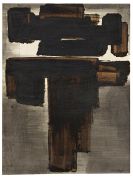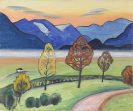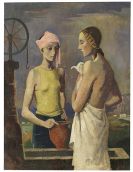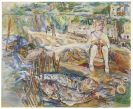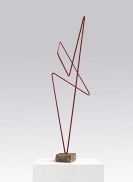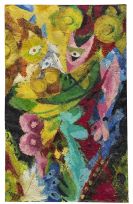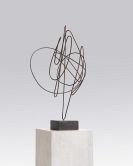
Asger Jorn
Vejrum/Jütland
1914 -
Aarhus
1973
The Danish artist Asger Jorn, actually Asger Oluf Jørgensen, was born in Vejrum near Struer on March 3, 1914. In 1945 he changes his last name to "Jorn". Asger Jorn receives an education for teaching from 1930-35, but already makes his first steps in painting during this time. As of 1935 he makes his first abstract paintings, finding inspiration in the rich ornamental art of the Vikings, the medieval frescoes in Denmark and Scandinavian folk art.
In 1936 he goes to Paris to attend Fernand Léger's Académie Contemporaine. Together with Léger he works on decorations for the "Pavillon des Temps Nouveaux" by Le Corbusier at the 1937 world exhibition. Paris is especially important for Asger Jorn in terms of its lively contemporary art scene. He examines the abstract paintings by Wassily Kandinsky or works of the surrealists, Max Ernst, Joan Miró, and Paul Klee fascinate him the most. He returns to Denmark in 1938 where his first one-man show takes place in Copenhagen the same year.
Asger Jorn employs many ways of protesting against Germany's occupation of Denmark, he works, for instance, for the magazines "Helhesten" (Hell Horse) and "Land og Folk". In 1945 he works on a series of 23 etchings titled "Occupations 1939-45". After the war he focuses on theoretic writings on art and on criticism of the capitalist society. He publishes many manifestos in the context of the anarchist "Situationist Internationale".
Together with Karel Appel, Constant, Corneille, Christian Dotremont and Joseph Noiret he initiates the artist group "CoBrA" in 1948 - an acronym of the city names Copenhagen, Brussels and Amsterdam, from where its members come. The first large "CoBrA" exhibition takes place at the Stedelijk Museum in Amsterdam as early as in 1949. The basic aim of "CoBrA" artists is the authentic expression of spontaneity in their art, which is modeled after folk art, art of mentally ill and graffiti - art that had so far been rejected as primitive and inartistic. "CoBrA" breaks up as early as in 1953, and Asger Jorn publishes monographies of the participating artists.
His first art-theoretic book "Helg og Hasard" (Salvation and Coincidence) is released in 1954. The same year he and Enrico Baj found the "Mouvement International pour un Bauhaus Imaginiste (MIBI)"- as an reaction to Max Bill and the Ulm University. In 1963 the "Institute for Comparative Vandalisme" is found. As of the 1960s the artist experiments with drawing over cheap department store paintings or 19th century salon paintings, the so-called "Modifications" and "Defigurations", which is to him a means of reevaluating bad taste and kitsch. He also makes ceramics, collages and sculptures, and turns to painting again as of 1966.
Asger Jorn dies in Aarhus on May 1, 1973.
Would you like to sell a work by Asger Jorn?
Infos for seller

